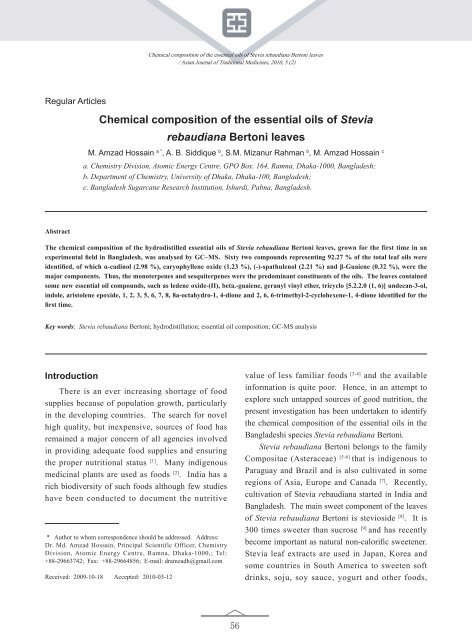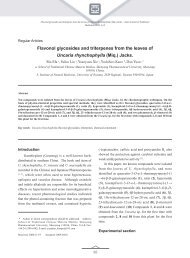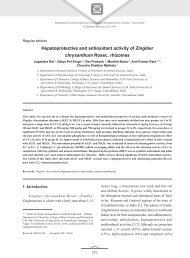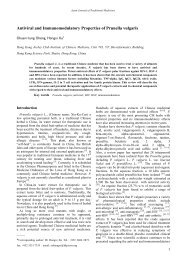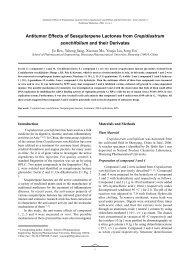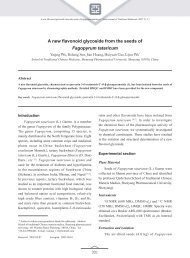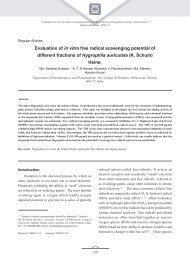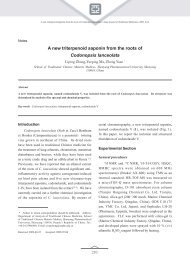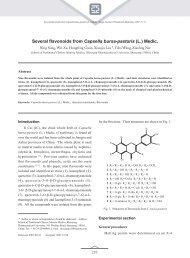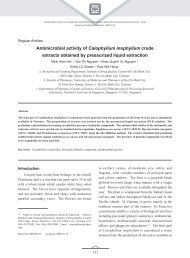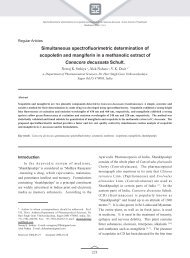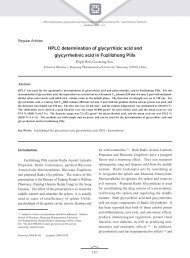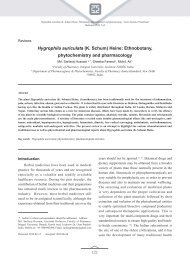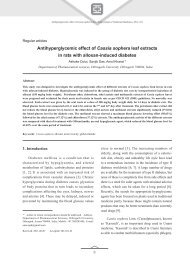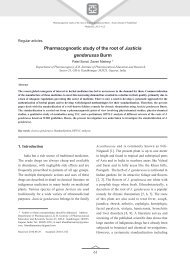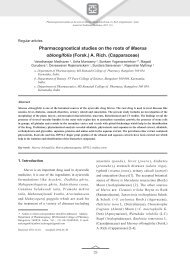Chemical composition of the essential oils of Stevia rebaudiana ...
Chemical composition of the essential oils of Stevia rebaudiana ...
Chemical composition of the essential oils of Stevia rebaudiana ...
Create successful ePaper yourself
Turn your PDF publications into a flip-book with our unique Google optimized e-Paper software.
<strong>Chemical</strong> <strong>composition</strong> <strong>of</strong> <strong>the</strong> <strong>essential</strong> <strong>oils</strong> <strong>of</strong> <strong>Stevia</strong> <strong>rebaudiana</strong> Bertoni leaves<br />
/ Asian Journal <strong>of</strong> Traditional Medicines, 2010, 5 (2)<br />
Regular Articles<br />
<strong>Chemical</strong> <strong>composition</strong> <strong>of</strong> <strong>the</strong> <strong>essential</strong> <strong>oils</strong> <strong>of</strong> <strong>Stevia</strong><br />
<strong>rebaudiana</strong> Bertoni leaves<br />
M. Amzad Hossain a * , A. B. Siddique b , S.M. Mizanur Rahman b , M. Amzad Hossain c<br />
a. Chemistry Division, Atomic Energy Centre, GPO Box. 164, Ramna, Dhaka-1000, Bangladesh;<br />
b. Department <strong>of</strong> Chemistry, University <strong>of</strong> Dhaka, Dhaka-100, Bangladesh;<br />
c. Bangladesh Sugarcane Research Institution, Ishurdi, Pabna, Bangladesh.<br />
Abstract<br />
The chemical <strong>composition</strong> <strong>of</strong> <strong>the</strong> hydrodistilled <strong>essential</strong> <strong>oils</strong> <strong>of</strong> <strong>Stevia</strong> <strong>rebaudiana</strong> Bertoni leaves, grown for <strong>the</strong> first time in an<br />
experimental field in Bangladesh, was analysed by GC–MS. Sixty two compounds representing 92.27 % <strong>of</strong> <strong>the</strong> total leaf <strong>oils</strong> were<br />
identified, <strong>of</strong> which α-cadinol (2.98 %), caryophyllene oxide (1.23 %), (-)-spathulenol (2.21 %) and β-Guaiene (0.32 %), were <strong>the</strong><br />
major components. Thus, <strong>the</strong> monoterpenes and sesquiterpenes were <strong>the</strong> predominant constituents <strong>of</strong> <strong>the</strong> <strong>oils</strong>. The leaves contained<br />
some new <strong>essential</strong> oil compounds, such as ledene oxide-(ΙΙ), beta.-guaiene, geranyl vinyl e<strong>the</strong>r, tricyclo [5.2.2.0 (1, 6)] undecan-3-ol,<br />
indole, aristolene epoxide, 1, 2, 3, 5, 6, 7, 8, 8a-octahydro-1, 4-dione and 2, 6, 6-trimethyl-2-cyclohexene-1, 4-dione identified for <strong>the</strong><br />
first time.<br />
Key words: <strong>Stevia</strong> <strong>rebaudiana</strong> Bertoni; hydrodistillation; <strong>essential</strong> oil <strong>composition</strong>; GC-MS analysis<br />
Introduction<br />
There is an ever increasing shortage <strong>of</strong> food<br />
supplies because <strong>of</strong> population growth, particularly<br />
in <strong>the</strong> developing countries. The search for novel<br />
high quality, but inexpensive, sources <strong>of</strong> food has<br />
remained a major concern <strong>of</strong> all agencies involved<br />
in providing adequate food supplies and ensuring<br />
<strong>the</strong> proper nutritional status [1] . Many indigenous<br />
medicinal plants are used as foods [2] . India has a<br />
rich biodiversity <strong>of</strong> such foods although few studies<br />
have been conducted to document <strong>the</strong> nutritive<br />
* Author to whom correspondence should be addressed. Address:<br />
Dr. Md. Amzad Hossain, Principal Scientific Officer, Chemistry<br />
Division, Atomic Energy Centre, Ramna, Dhaka-1000,; Tel:<br />
+88-29663742; Fax: +88-29664856; E-mail: dramzadh@gmail.com<br />
Received: 2009-10-18 Accepted: 2010-03-12<br />
value <strong>of</strong> less familiar foods [3-4] and <strong>the</strong> available<br />
information is quite poor. Hence, in an attempt to<br />
explore such untapped sources <strong>of</strong> good nutrition, <strong>the</strong><br />
present investigation has been undertaken to identify<br />
<strong>the</strong> chemical <strong>composition</strong> <strong>of</strong> <strong>the</strong> <strong>essential</strong> <strong>oils</strong> in <strong>the</strong><br />
Bangladeshi species <strong>Stevia</strong> <strong>rebaudiana</strong> Bertoni.<br />
<strong>Stevia</strong> <strong>rebaudiana</strong> Bertoni belongs to <strong>the</strong> family<br />
Compositae (Asteraceae) [5-6] that is indigenous to<br />
Paraguay and Brazil and is also cultivated in some<br />
regions <strong>of</strong> Asia, Europe and Canada [7] . Recently,<br />
cultivation <strong>of</strong> <strong>Stevia</strong> <strong>rebaudiana</strong> started in India and<br />
Bangladesh. The main sweet component <strong>of</strong> <strong>the</strong> leaves<br />
<strong>of</strong> <strong>Stevia</strong> <strong>rebaudiana</strong> Bertoni is stevioside [8] . It is<br />
300 times sweeter than sucrose [9] and has recently<br />
become important as natural non-calorific sweetener.<br />
<strong>Stevia</strong> leaf extracts are used in Japan, Korea and<br />
some countries in South America to sweeten s<strong>of</strong>t<br />
drinks, soju, soy sauce, yogurt and o<strong>the</strong>r foods,<br />
56
<strong>Chemical</strong> <strong>composition</strong> <strong>of</strong> <strong>the</strong> <strong>essential</strong> <strong>oils</strong> <strong>of</strong> <strong>Stevia</strong> <strong>rebaudiana</strong> Bertoni leaves<br />
/ Asian Journal <strong>of</strong> Traditional Medicines, 2010, 5 (2)<br />
while in <strong>the</strong> United States it is used as a dietary<br />
supplement and in Bangladesh as an antidiabetic<br />
tea. <strong>Stevia</strong> <strong>rebaudiana</strong> Bertoni sweetener extracts<br />
have been suggested to have a beneficial effect on<br />
human health because <strong>of</strong> <strong>the</strong>ir antihypertensive [10-11] ,<br />
antihyperglycemic [12] , anticariogenic [13] and antihuman<br />
rotavirus activities [14] . These sweeteners are<br />
also thought to influence glucose metabolism [15-16]<br />
and renal function [17] . The increasing importance<br />
<strong>of</strong> <strong>essential</strong> <strong>oils</strong> in various areas <strong>of</strong> human activity<br />
(pharmacy, cosmetics as well as <strong>the</strong> food and drink<br />
industries) has made this field very interesting<br />
for chemical investigators. Current research into<br />
<strong>Stevia</strong> <strong>rebaudiana</strong> Bertoni <strong>essential</strong> oil, is very<br />
active. However, it should be remembered that <strong>the</strong><br />
sweetening effect is simply a pleasant by-product. The<br />
primary reason that stevia is combined with o<strong>the</strong>r<br />
herbs is to enhance <strong>the</strong> nutritive value <strong>of</strong> <strong>the</strong>se o<strong>the</strong>r<br />
herbs! <strong>Stevia</strong> is, after all, nutrient-rich, containing<br />
substantial amounts <strong>of</strong> protein, calcium, phosphorous<br />
and o<strong>the</strong>r important nutrients [18-19] .<br />
Carrying <strong>the</strong> above considerations a step fur<strong>the</strong>r,<br />
<strong>the</strong>re are many very legitimate reasons for using<br />
stevia as a medicinal food. In spite <strong>of</strong> <strong>the</strong> prominence<br />
stevia has attracted as a flavor enhancer, it contains<br />
a variety <strong>of</strong> constituents besides <strong>the</strong> steviosides<br />
and rebaudiosides, including <strong>the</strong> nutrients specified<br />
above and lots <strong>of</strong> sterols, triterpenes, flavonoids, and<br />
tannins, as well as being an extremely rich volatile<br />
oil containing lots <strong>of</strong> aromatic agents, aldehydes,<br />
monoterpenes and sesquiterpenes [20] . These and o<strong>the</strong>r,<br />
as yet unidentified constituents, probably have a variety<br />
<strong>of</strong> effects on human physiology and may help explain<br />
some <strong>of</strong> <strong>the</strong> reported <strong>the</strong>rapeutic uses <strong>of</strong> stevia.<br />
Therefore, <strong>the</strong> aim <strong>of</strong> <strong>the</strong> present study is to<br />
examine <strong>the</strong> chemical <strong>composition</strong> <strong>of</strong> <strong>the</strong> <strong>essential</strong> <strong>oils</strong><br />
isolated from <strong>the</strong> leaves <strong>of</strong> <strong>Stevia</strong> <strong>rebaudiana</strong> Bertoni<br />
by GC–MS.<br />
Material and methods<br />
Plant material<br />
The green leaves <strong>of</strong> <strong>Stevia</strong> <strong>rebaudiana</strong> Bertoni<br />
were collected from <strong>the</strong> Bangladesh Sugarcane<br />
Research Institute, Ishurdi, Pabna, Bangladesh. The<br />
plants were harvested during <strong>the</strong> month <strong>of</strong> September,<br />
2009. The leaves were collected at 2:00 pm-3:00 pm<br />
on September 2, 2009 and packed in polyethylene<br />
bags and stored at 4 °C until required. All chemicals<br />
used were <strong>of</strong> research grade purity.<br />
GC-MS analysis<br />
The GC–MS analysis <strong>of</strong> <strong>the</strong> <strong>essential</strong> oil samples<br />
<strong>of</strong> <strong>Stevia</strong> <strong>rebaudiana</strong> Bertoni was performed using a<br />
Varian GC–MS instrument (Model Varian CP 3800,<br />
USA) equipped with a VF-5 fused silica capillary<br />
column (30 m×0.25 i. d. mm film thickness 0.25 µm,<br />
Varian, USA). For GC–MS detection, an electron<br />
ionization system with ionization energy <strong>of</strong> 70 eV<br />
was used. Helium gas was used as a carrier gas at<br />
a constant flow rate <strong>of</strong> 1 ml/min. The injector and<br />
mass transfer line temperatures were set at 250 °C<br />
and 300 °C, respectively. The oven temperature was<br />
programmed from 50 °C to 200 °C at 8 °C/min, and<br />
<strong>the</strong>n kept iso<strong>the</strong>rmal for 20 min and finally raised to<br />
300 °C at 10 °C/min. Diluted samples (1/100 v/v, in<br />
methanol) <strong>of</strong> 0.2 µl were manually injected in splitless<br />
mode. Identification <strong>of</strong> compounds <strong>of</strong> <strong>the</strong> <strong>essential</strong> oil<br />
was based on GC retention times on <strong>the</strong> VF-5 capillary<br />
column, with computer matching <strong>of</strong> mass spectra with<br />
those <strong>of</strong> standards (Mainlab, Replib and Tutorial data<br />
<strong>of</strong> GC–MS systems).<br />
Extraction and isolation <strong>of</strong> <strong>essential</strong> oil<br />
The air-dried leaves and stems (250 g each)<br />
<strong>of</strong> <strong>Stevia</strong> <strong>rebaudiana</strong> Bertoni were subjected to<br />
hydrodistillation for 3h using a Clevenger type<br />
apparatus. The distillate was mixed with 1g NaCl and<br />
20 ml dichloromethane (DCM) in a separatory funnel,<br />
and shaking was continued by hand for 40 min and <strong>the</strong><br />
mixture was <strong>the</strong>n allowed to stand for 15 min. Finally,<br />
<strong>the</strong> DCM layer was collected in a round bottom flask<br />
for rotary evaporation and evaporated at 30 °C until<br />
57
<strong>Chemical</strong> <strong>composition</strong> <strong>of</strong> <strong>the</strong> <strong>essential</strong> <strong>oils</strong> <strong>of</strong> <strong>Stevia</strong> <strong>rebaudiana</strong> Bertoni leaves<br />
/ Asian Journal <strong>of</strong> Traditional Medicines, 2010, 5 (2)<br />
5 ml remained. The oil was dried over anhydrous<br />
sodium sulphate and stored in a sealed vial at 4 o C<br />
until fur<strong>the</strong>r analysis.<br />
Results and discussion<br />
<strong>Chemical</strong> <strong>composition</strong> <strong>of</strong> <strong>essential</strong> <strong>oils</strong><br />
The GC-MS total ion chromatogram (TIC)<br />
<strong>of</strong> <strong>the</strong> <strong>essential</strong> <strong>oils</strong> from <strong>the</strong> leaves <strong>of</strong> <strong>Stevia</strong><br />
<strong>rebaudiana</strong> Bertoni is shown in Fig. 1. GC–MS<br />
analyses <strong>of</strong> <strong>the</strong> <strong>oils</strong> led to <strong>the</strong> identification <strong>of</strong> 62<br />
different compounds, representing 92.27 <strong>of</strong> <strong>the</strong> total<br />
<strong>oils</strong> from <strong>the</strong> leaves. The identified compounds are<br />
listed in Table 1 according to <strong>the</strong>ir elution order<br />
on a VF-5 capillary column. The <strong>oils</strong> contained a<br />
complex mixture consisting <strong>of</strong> mainly oxygenated<br />
monoterpene and sesquiterpene hydrocarbons. The<br />
major compounds detected in <strong>the</strong> leaves and stems<br />
<strong>oils</strong>, respectively, were (-)-spathulenol, caryophyllene<br />
oxide, caryophyllene, ledene oxide-(ΙΙ), β.-guaiene,<br />
geranyl vinyl e<strong>the</strong>r, tricyclo [5.2.2.0 (1, 6)] undecan-<br />
3-ol, indole, aristolene epoxide, 1, 2, 3, 5, 6, 7, 8,<br />
8a-octahydro-1, 4-dione and 2, 6, 6-trimethyl-2-<br />
cyclohexene-1,4-dione (Table 1). In <strong>the</strong> terpene<br />
group, seven compounds, ledene oxide-(ΙΙ), β-guaiene,<br />
geranyl vinyl e<strong>the</strong>r, tricyclo [5.2.2.0 (1,6)] undecan-<br />
3-ol, indole, aristolene epoxide, 1, 2, 3, 5, 6, 7, 8,<br />
8a-octahydro-1, 4-dione and 2, 6, 6-trimethyl-2-<br />
cyclohexene-1, 4-dione, were present that had not<br />
previously been reported as constituents <strong>of</strong> <strong>Stevia</strong><br />
<strong>rebaudiana</strong> Bertoni. All <strong>the</strong> <strong>essential</strong> <strong>oils</strong> exhibited<br />
very potent biological activity.<br />
Hydrodistillation <strong>of</strong> <strong>the</strong> leaves <strong>of</strong> <strong>Stevia</strong><br />
<strong>rebaudiana</strong> Bertoni gave dark yellowish <strong>oils</strong> with <strong>the</strong><br />
major components being oxygenated monoterpenes<br />
and sesquiterpenes, and <strong>the</strong>ir respective hydrocarbons.<br />
In recent years, several researchers have reported<br />
that monoterpene and sesquiterpene hydrocarbons<br />
and <strong>the</strong>ir oxygenated derivatives are <strong>the</strong> major<br />
components <strong>of</strong> <strong>essential</strong> <strong>oils</strong> <strong>of</strong> plant origin, and <strong>the</strong>se<br />
have enormous potential to strongly inhibit microbial<br />
pathogens [21-22] . In general, <strong>the</strong> active antimicrobial<br />
compounds <strong>of</strong> <strong>essential</strong> <strong>oils</strong> are terpenes, which are<br />
phenolic in nature, it would seem reasonable that <strong>the</strong>ir<br />
antimicrobial or anti-fungal mode <strong>of</strong> action might be<br />
related to that <strong>of</strong> o<strong>the</strong>r compounds.<br />
e constituents <strong>of</strong> <strong>essential</strong> oil from <strong>the</strong> leaves <strong>of</strong> <strong>Stevia</strong><br />
Counts<br />
igure 1. A typical chromatogram <strong>of</strong> <strong>the</strong> constituents <strong>of</strong> <strong>essential</strong> oil from <strong>the</strong> leaves <strong>of</strong> <strong>Stevia</strong><br />
Rebaudiana Bertoni<br />
t (min)<br />
Figure 1. A typical chromatogram <strong>of</strong> <strong>the</strong> constituents <strong>of</strong> <strong>essential</strong> oil from <strong>the</strong> leaves <strong>of</strong> <strong>Stevia</strong><br />
Fig. 1. A typical Figure chromatogram 1. A typical chromatogram <strong>of</strong> <strong>the</strong> constituents <strong>of</strong> <strong>the</strong> Rebaudiana Figure constituents <strong>of</strong> 1. <strong>essential</strong> A typical Bertoni <strong>of</strong> oil <strong>essential</strong> chromatogram from <strong>the</strong> oil from leaves <strong>of</strong> <strong>the</strong> <strong>of</strong> leaves constituents <strong>Stevia</strong> <strong>of</strong> <strong>rebaudiana</strong> <strong>Stevia</strong> <strong>of</strong> <strong>essential</strong> Bertoni oil from <strong>the</strong> leaves <strong>of</strong><br />
Rebaudiana Bertoni<br />
Rebaudiana Bertoni<br />
<br />
<br />
Figure 1. A Figure typical 1. chromatogram A typical chromatogram <strong>of</strong> <strong>the</strong> constituents <strong>of</strong> <strong>the</strong> constituents <strong>of</strong> <strong>essential</strong> <strong>of</strong> oil <strong>essential</strong> from <strong>the</strong>oil leaves from <strong>of</strong> <strong>the</strong><strong>Stevia</strong><br />
leaves o<br />
Rebaudiana Rebaudiana<br />
Figure Bertoni Bertoni<br />
1. A typical chromatogram <strong>of</strong> <strong>the</strong> constituents <strong>of</strong> <strong>essential</strong> oil from <strong>the</strong> le<br />
58 Rebaudiana Bertoni
<strong>Chemical</strong> <strong>composition</strong> <strong>of</strong> <strong>the</strong> <strong>essential</strong> <strong>oils</strong> <strong>of</strong> <strong>Stevia</strong> <strong>rebaudiana</strong> Bertoni leaves<br />
/ Asian Journal <strong>of</strong> Traditional Medicines, 2010, 5 (2)<br />
Table 1. Percentage <strong>composition</strong> <strong>of</strong> <strong>the</strong> volatile leaf <strong>oils</strong> <strong>of</strong> <strong>Stevia</strong><br />
Compound RT Leaves (%)<br />
5, 4-Benzyloxy-2-fluoro-5-hydroxy benzaldehyde 3.412 4.68<br />
3-Bromobutyric acid 4.024 4.15<br />
Undecanol-5 6.377 0.18<br />
1-Hepten-3-ol 6.782 0.03<br />
Cyclohexene, 4-bromo- 7.810 0.05<br />
Benzyl-diseryl phosphate 7.954 4.82<br />
1, 3, 5-Cycloheptatriene 8.120 3.65<br />
α-Methyl-α-[4-methyl]-3-pentene 8.523 0.60<br />
1, 6-Octadien-3-ol, 3, 7-dimethyl- 9.023 2.22<br />
Cis-3-hexenyl-iso-butyrate 9.109 0.38<br />
Cyclopentasiloxane, decamethyl- 9.372 0.88<br />
Phenylethyl alcohol 9.421 1.28<br />
2, 6, 6-Trimethyl-2-cyclohexene-1, 4-dione 9.975 0.13<br />
3-Cyclohexene-1-methanol 10.884 0.53<br />
2-Isopropenyl-5-methylhex-4-enal 11.343 0.29<br />
Bicyclo [2.2.1] hept-2-ene, 1, 7, 7-trimethyl- 11.478 0.13<br />
5-Amino-2-methoxyphenol 11.598 0.09<br />
Geranyl vinyl e<strong>the</strong>r 11.778 0.14<br />
Cyclohexasiloxane, dodecamethyl- 12.318 4.40<br />
Indole 12.778 0.17<br />
2-Methoxy-4-vinylphenol 12.960 0.18<br />
Phenol, 2-methoxy-3-(2-propenyl)- 13.624 0.19<br />
1-(2, 6, 6-Trimethyl-1, 3-cyclo)-2-buten-1-one 14.028 0.06<br />
Cyclohexane, 1-ethyl-1-methyl-2, 4-bis- 14.164 0.09<br />
Caryophyllene 14.715 0.08<br />
Tricyclo [3.3.0.0 (2, 8)] octan-3-one, 4-methyl 14.822 0.07<br />
1, 6, 10-Dodecatriene, 7, 11-dimethyl-3-methyl 15.048 0.02<br />
3-Buten-2-one, 4-(2, 6, 6-trimethyl-1-cyclo)- 15.615 0.03<br />
3-Buten-2-one, 4-(2, 6, 6-trimethyl-7-oxab)- 15.677 0.06<br />
Naphlalene, 1, 2, 3, 5, 6, 7, 8, 8a-octahydro- 15.822 0.05<br />
Heptasiloxane, hexadecamethyl- 16.092 0.04<br />
Berjomotol, Z-α-trans- 16.294 0.08<br />
Lanceol, cis- 16.352 0.09<br />
2 (4H)-Benz<strong>of</strong>uraone, 5, 6, 7, 7a-tetrahydro 16.584 0.15<br />
1, 6, 10-Dodecatrien-3-ol, 3, 7, 11-trimethyl 16.747 2.26<br />
Epoxy-α-terpenyl acetate 16.916 0.76<br />
Benzene, 1, 1´-(1, 1, 2, 2-tetramethyl-1, 2-ethanediyl) bis- 17.078 0.08<br />
(-)-Spathulenol 17.195 2.21<br />
Caryophyllene oxide 17.282 1.23<br />
Cyclooctasiloxane, hexadecamethyl- 17.374 2.23<br />
Santalol, cis-α- 17.527 0.07<br />
5α-Hydroxy-4α-8, 10. 11-tetram 17.605 0.09<br />
Isoaromadendrene epoxide 17.678 0.35<br />
β-Guaiene 17.975 0.30<br />
Ledene oxide-(ΙΙ) 17.735 0.21<br />
59
<strong>Chemical</strong> <strong>composition</strong> <strong>of</strong> <strong>the</strong> <strong>essential</strong> <strong>oils</strong> <strong>of</strong> <strong>Stevia</strong> <strong>rebaudiana</strong> Bertoni leaves<br />
/ Asian Journal <strong>of</strong> Traditional Medicines, 2010, 5 (2)<br />
Continued Table 1<br />
Naphthalene, 1, 2, 3, 4, 4a, 5, 6, 8a-octa-hydro- 18.085 3.15<br />
α-Cadinol 18.292 2.98<br />
Tricyclo [5.2.2.0 (1, 6)] undecan-3-ol, 2-methyl 18.513 1.24<br />
6-Isopropenyl-4, 8a-dimethyl-1, 2, 3, 5, 6, 7-hexahydroxyl 18.828 0.11<br />
Aristolene epoxide 19.657 0.18<br />
Z, Z, Z-4, 6, 9-Nodadecatriene 20.035 0.06<br />
2-Pentadecanone, 6, 10, 14-trimethyl- 20.611 0.04<br />
Phallic acid, cyclohexyl isohexyl ester 21.078 0.06<br />
Pentadecacanoic, 14-methyl-, methyl- 22.048 0.17<br />
1, 2-Benzenedicarboxylic acid, butyl 2-ethyl 22.888 0.34<br />
3-Methyl-2-pent-2-enyl-cyclopent-2-enon 22.484 0.33<br />
1H-Naphtho [2, 1-b] pyrane, 3-e<strong>the</strong>nydodecane 24.040 9.83<br />
9H-Naphtho [2, 1-b] pyran-9-one, 3-e<strong>the</strong>nyl 31.735 0.71<br />
Pregnanetriol 36.284 2.23<br />
Tritetracontane 41.810 0.08<br />
1, 2-Benzenedicarboxylic acid, diisooctyl 45.078 0.18<br />
Benzaldehyde 6.615 0.35<br />
Total (Sixty two) 92.27<br />
The <strong>essential</strong> <strong>oils</strong> <strong>of</strong> <strong>Stevia</strong> <strong>rebaudiana</strong> Bertoni<br />
showed marked antifungal effects against all <strong>the</strong><br />
fungi tested [23] . This activity could be attributed to<br />
<strong>the</strong> presence <strong>of</strong> α-cadinol (2.98 %), caryophyllene<br />
oxide (1.23 %), (-)-spathulenol (2.21 %), β-guaiene<br />
(0.32 %), ledene oxide-(ΙΙ), geranyl vinyl e<strong>the</strong>r,<br />
tricyclo [5.2.2.0 (1, 6)] undecan-3-ol, indole,<br />
aristolene epoxide, 1, 2, 3, 5, 6, 7, 8, 8a-octahydro-1,<br />
4-dione and 2, 6, 6-trimethyl-2-cyclohexene-1,<br />
4-dione which significantly inhibited <strong>the</strong> growth <strong>of</strong><br />
all <strong>the</strong> phytopathogens tested, and/or o<strong>the</strong>r major and<br />
minor oxygenated monoterpenes and sesquiterpenes<br />
present in <strong>the</strong> <strong>oils</strong> [23] .<br />
In spite <strong>of</strong> this, most <strong>of</strong> <strong>the</strong>se <strong>oils</strong> are available for<br />
purchase on <strong>the</strong>ir own or as a part <strong>of</strong> pharmaceutical<br />
or cosmetic products, indicating that toxic effects<br />
do not prevent <strong>the</strong>ir use. However, <strong>the</strong> ongoing<br />
investigation <strong>of</strong> <strong>the</strong>ir toxic or irritant properties is<br />
imperative, especially when considering any new<br />
products for human use, be it medicinal or o<strong>the</strong>rwise.<br />
In our opinion, <strong>the</strong> major components <strong>of</strong><br />
<strong>Stevia</strong> <strong>rebaudiana</strong> Bertoni <strong>essential</strong> <strong>oils</strong> are<br />
α-cadinol (2.98 %), caryophyllene oxide (1.23 %),<br />
(-)-spathulenol (2.21 %) and β-guaiene (0.32 %)<br />
and <strong>the</strong>y exhibit important anti-fungal activities.<br />
These anti-fungal activities have also been<br />
reported by o<strong>the</strong>rs [24] . However, <strong>the</strong> more minor<br />
components,such as ledene oxide-(ΙΙ), geranyl vinyl<br />
e<strong>the</strong>r, tricyclo [5.2.2.0 (1, 6)] undecan-3-ol, indole,<br />
aristolene epoxide, 1, 2, 3, 5, 6, 7, 8, 8a-octahydro-1,<br />
4-dione and 2, 6, 6-trimethyl-2-cyclohexene-1,<br />
4-dione, also contribute to <strong>the</strong> antifungal activity <strong>of</strong><br />
<strong>the</strong>se <strong>oils</strong> [23] .<br />
Conclusion<br />
A quantitative analysis <strong>of</strong> <strong>the</strong> <strong>essential</strong> oil from<br />
<strong>the</strong> leaves <strong>of</strong> Bangladeshi <strong>Stevia</strong> <strong>rebaudiana</strong> Bertoni<br />
showed that mono and sesquiterpenes are major known<br />
constituents (about 50 compounds) [21-23] out <strong>of</strong> <strong>the</strong><br />
62 compounds identified. Some <strong>of</strong> <strong>the</strong>se compounds<br />
were identified for <strong>the</strong> first time in this plant (ledene<br />
oxide-(ΙΙ), geranyl vinyl e<strong>the</strong>r, tricyclo [5.2.2.0 (1, 6)]<br />
undecan-3-ol, indole, aristolene epoxide, 1, 2, 3, 5, 6,<br />
7, 8, 8a-octahydro-1, 4-dione and 2, 6, 6-trimethyl-<br />
2-cyclohexene-1, 4-dione). It is obvious that <strong>Stevia</strong><br />
<strong>rebaudiana</strong> Bertoni grown in Bangladesh possesses<br />
60
<strong>Chemical</strong> <strong>composition</strong> <strong>of</strong> <strong>the</strong> <strong>essential</strong> <strong>oils</strong> <strong>of</strong> <strong>Stevia</strong> <strong>rebaudiana</strong> Bertoni leaves<br />
/ Asian Journal <strong>of</strong> Traditional Medicines, 2010, 5 (2)<br />
certain specific characteristics due to <strong>the</strong> cultivation<br />
conditions <strong>of</strong> <strong>the</strong> local plantations i.e., location, soil,<br />
climate and plant growing conditions.<br />
Acknowledgement<br />
We are grateful to Dr. M. Ali, Chief Scientific<br />
Officer and Head, Chemistry Division, Atomic<br />
Energy Centre, Ramna, Dhaka, for his continuous<br />
encouragement during <strong>the</strong> work and all laboratory<br />
facilities. We also thank Mr. Zahidul Islam and Mr.<br />
Ayub Ali for <strong>the</strong>ir help with sample preparation.<br />
References<br />
[1] Sankhala A, Sankhala AK, Bhatnagar B, Singh A.<br />
Nutrient <strong>composition</strong> <strong>of</strong> less familiar leaves consumed by<br />
<strong>the</strong> tribals <strong>of</strong> Udaipur region. J Food Sci Technol, 2005,<br />
42(5): 446-48.<br />
[2] Hill AF. Economy Botany. A textbook <strong>of</strong> useful plants and<br />
plant products. 2nd ed. New York: McGarw-Hill Book<br />
Company Inc, 1952, 64-93.<br />
[3] Rajalakshm P, Geeravani P. Studies <strong>of</strong> tribal foods <strong>of</strong><br />
south India: Effects <strong>of</strong> processing methods <strong>of</strong> <strong>the</strong> vitamins<br />
and in vitro protein digestibility <strong>of</strong> cereals/millets and<br />
legumes. J Food Sci Technol, 1990, 27(5): 260-3.<br />
[4] Mohan VR, Janardhanan K. <strong>Chemical</strong> determination <strong>of</strong><br />
nutrition and antinutrition properties in tribal pulses. J<br />
Food Sci Technol, 1995, 32: 465-9.<br />
[5] Brandle JE, Starratt AN, Gijzen M. <strong>Chemical</strong> <strong>composition</strong><br />
<strong>of</strong> <strong>essential</strong> oil from medicinal plants. Can J Plant Sci,<br />
1998, 78(4): 527.<br />
[6] Midmore DJ, Rank AH. A New Rural Industry-Stavia-To<br />
Replace Imported <strong>Chemical</strong> Sweeteners, A report for <strong>the</strong><br />
rural industries research and development cooperation,<br />
Australia, RIRDC Project No. UCQ-16A, 2002, 1-3.<br />
[7] Crammar B, Ikan R. Progress in <strong>the</strong> chemistry and<br />
properties <strong>of</strong> <strong>the</strong> rebaudiosides. Int: Developments in<br />
sweeteners, Grenby TH (Ed). Elsevierv Applied Science:<br />
London; UK, 1987, 45-6.<br />
[8] Geuns JMC. Safety <strong>of</strong> stevia and steviosides. Recent Res<br />
Dev Phytochem, 2007, 4: 75-88.<br />
[9] Soejarto DD, Kinghorn DD, Farnsworth NR. Potential<br />
sweetening agents <strong>of</strong> plant origin. III. Organoleptic<br />
evaluation <strong>of</strong> <strong>Stevia</strong> leaf herbarium samples for sweetness.<br />
J Nat Prod, 1982, 45(5): 590-9.<br />
[10] Chan P, Tomlinson B, Chen Y, Liu J, Heish J, Cheng J. A<br />
double blind placebo-controlled study <strong>of</strong> <strong>the</strong> effectiveness<br />
and tolaribility <strong>of</strong> <strong>the</strong> stevioside in human hypertensive.<br />
Br J Clin Pharmacol, 2000, 50(3): 215-20.<br />
[11] Lee CN, Wong K, .Liu J, Chen Y, Chen J, Chan P.<br />
Inhabitory effect <strong>of</strong> steviosides on calcium influx to<br />
produce antihypertension. Plant Med, 2001, 67(9): 796-9.<br />
[12] Jeppesen PB, Gregersen S, Poulsen CR, Hermansen K.<br />
Steviosides acts directly on pancreatic cells to secrete<br />
insolin: Actions independent <strong>of</strong> cyclic adenosine<br />
monophosphate and adenosine triphosphate –sensitive k +<br />
channel activity. Metabolism, 2000, 49(2): 208-14.<br />
[13] Das S, Das AK, Murfhy RA, Punwani IC, Nasution NP,<br />
Kinghom AD. Evaluation <strong>of</strong> <strong>the</strong> cariogenic potential <strong>of</strong> <strong>the</strong><br />
intense natural sweetners steviosides and rebaudiosides A.<br />
Caries Res, 1992, 26(5): 363-6.<br />
[14] Takahashi K, Matsuda M, Oashi K, Yaniguchi K,<br />
Nakagomi O, Abe Y, Mori S, Sato N, Okuyani K, Shigeta<br />
S. Analysis <strong>of</strong> anti-rotavirus activity <strong>of</strong> extract from <strong>Stevia</strong><br />
<strong>rebaudiana</strong>. Antiviral Res, 2001, 49(1): 15-24.<br />
[15] Suanarunsawat T, Chaiyabutr N. The effect <strong>of</strong> steviosides<br />
on glucose metabolism in ran. Can. J, Physiol. Oharmacol,<br />
1997, 75(8): 976-82.<br />
[16] Toskulkao C, Su<strong>the</strong>erawatananon M, Wanichanon C,<br />
Saitongdee P, Suttagit M. Effect <strong>of</strong> stevioside and steviol<br />
on intestinal glucose absorption hamsters. J. Nutr Sci.<br />
Vitaminal, 1995, 41(1): 105-13.<br />
[17] Jutbha P, Toskulkao C, Chatsudthipong V. Effect <strong>of</strong><br />
Stevioside on PAH transport by isolated perfused rabbit<br />
renal provinal tubule. Can. J Physiol Pharmacol, 2000, 78<br />
(9): 737-44.<br />
[18] Viana AM, Metivier J. Changes in <strong>the</strong> levels <strong>of</strong> total<br />
soluble proteins and sugars during leaf ontogeny in <strong>Stevia</strong><br />
<strong>rebaudiana</strong> Bert. Annal Bota, 1998, 45(4): 469-74.<br />
[19] Hierbas Medicinales, Caa Jhee. Bulletin, Centro de<br />
Promocion de las Exportaciones, Ministerio de Industria<br />
Y Comercio, Paraguay, 2003, 43-66.<br />
[20] Kinghorn AD, Soejarto DD. Current status <strong>of</strong> stevioside<br />
as a sweetening agent for human use.” Economic and<br />
Medicinal Plant Research, Volume 1, Wagner H, Hikino<br />
H, Farnsworth NR 2nd ed, New York: Academic Press,<br />
1985, 1-51.<br />
[21] Gudzic B, Djokovic D, Vajs V, Palic R, Stojanovic G.<br />
Composition and antimicrobial activity <strong>of</strong> <strong>the</strong> <strong>essential</strong> oil<br />
<strong>of</strong> Hypericum maculatum Crantz. Flavour Frag J, 2002,<br />
17(5): 392–4.<br />
[22] Cakir A, Kordali S, Zengin H, Izumi S, Hirata T.<br />
Composition and antifungal activity <strong>of</strong> <strong>essential</strong> <strong>oils</strong><br />
isolated from Hypericum hyssopifolium and Hypericum<br />
heterophyllum. Flavour Frag J, 2004, 19(1): 62–8.<br />
[23] Markovic IS, Darmati Z, Abramovic B. <strong>Chemical</strong><br />
<strong>composition</strong> <strong>of</strong> <strong>the</strong> leave extracts <strong>of</strong> Stavia <strong>rebaudiana</strong><br />
Bertoni grown experimentally in Vojvodina. J Serb Chem<br />
Soc, 2008, 73(3): 283-97.<br />
61


